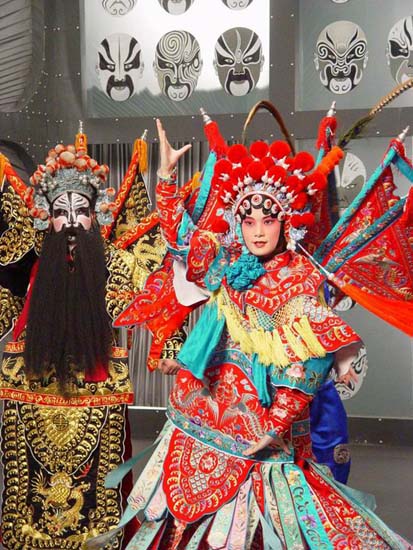(单词翻译:单击)
原文
戏曲
Chinese Opera

原文:
Chinese Opera is the traditional form of Chinese theatre, which combines dialogue, music, vocal performance, dance, kung fu(gong fu), acrobatics, and so on. It is one of the three oldest theatrical art forms in the world, together with Greek Theatre and Indian Sanskrit Opera. The origin of it can be traced back to the singing and dancing and religious rituals in primitive times. But not until the late Song Dynasty (960-1279 A.D.) and the early Yuan Dynasty (1279-1368 A.D.) through a very long period of development and reforms did Chinese Opera form a mature and complete artistic system. According to partial statistics, there are over 360 regional opera styles in China, among which, Kunqu Opera is one of the oldest extant forms of Chinese Opera.
Kunqu Opera, which evolved from the Kunshan melody in the Yuan Dynasty, boasts a 600-year history. Renowned for its gentle and clear vocals, beautiful and refined tunes, it gradually spread from Kunshan region nearby Suzhou to the rest of China and dominated Chinese theatre from the 16th to the 18th centuries, widely popular among gentry and common people. Kunqu is known as the "mother" of a hundred operas, because of its influence on other Chinese theatre forms, including Beijing opera. In 2001, Kunqu was listed as one of the Masterpieces of the Oral and Intangible Heritage of Humanity by UNESCO.
Nearly disappeared by the early 20th century, Kunqu now is thriving again. Plays that continue to be famous today include The Peony Pavilion by the most gifted playwright of the Ming Dynasty, Tang Xianzu, the contemporary of William Shakespeare, Fifteen Strings of Copper Coins, by Zhu Suchen, The Peach Blossom Fan by Kong Shangren, The Palace of Eternal Youth by Hong Sheng. In addition, many classical scenes from other extinct pieces have survived.
Among the hundreds of forms of opera throughout China, Beijing Opera has the greatest influence and is therefore regarded as a national opera. The roles in Beijing Opera are divided into four main types according to the sex, age, social status, and profession of the character: Sheng (male roles), Dan (female roles), Jing (roles with painted faces) and Chou (clowns) and besides, there are some other minor types.
Symbolism prevails in Beijing Opera, the stage of which knows no limit in space or time. The music of Beijing Opera mainly combines the Er Huang tune, the Xi Pi tune, and melodies of Kunqu. Typical Chinese musical instruments are used in a Beijing Opera orchestra, such as Jing Hu (two-string fiddle), Pi Pa (Chinese lute), Sheng (reed pipes), drums and gongs, etc.
Facial painting is a prominent feature of Beijing Opera. It shows the character's age, profession and personality by using different patterns and colors. Each color symbolizes a certain characteristic; red for loyalty and uprightness; black for a rough, stern or honest nature; yellow for rashness and fierceness; white for cunningness and deceitfulness; purple for bravery and wisdom; blue for a daring and vigorous character; gold and silver for gods and demons.
翻译
翻译:
戏曲是中国传统的戏剧形式,综合了对白、音乐、歌唱、舞蹈、武术和杂技等多种表演方式。它与希腊戏剧和印度梵剧并称世界最古老的戏剧形式。中国戏曲的起源可追溯到原始社会的歌舞和宗教仪式,并经过漫长的发展和革新,才逐渐在宋元时期形成了比较完整成熟的艺术体系。据不完全统计,我国各地约有三百六十多种戏曲剧种,其中昆曲是现存最古老的剧种之一。
昆曲Kunqu Opera
昆曲发源于元朝的昆山腔,至今已有六百多年的历史。它逐渐从苏州昆山地区遍布全国各地,成为了从十六世纪到十八世纪末中国影响最大的剧种,受到了士大夫阶层和平民百姓的普遍欢迎。昆曲以清柔委婉的唱腔、优雅细腻的曲调著称。包括京剧在内的很多剧种都是在昆曲的基础上发展而来,因而昆曲素有“百戏之母”的雅称。2001年,昆曲被联合国教科文组织命名为“人类口述和非物质遗产代表作”。
昆曲尽管在20世纪初濒临灭绝,现又再度兴盛。现存著名的剧目包括与莎士比亚同时期的明代戏曲大家汤显祖的《牡丹亭》、朱素臣的《十五贯》,孔尚任的《桃花扇》,洪升的《长生殿》,另外还有不少经典的折子戏流传至今。
京剧 Beijing Opera
在中国数百种戏曲之中,京剧拥有最广泛的影响力,被称为国剧。京剧的角色主要根据性别、年龄、社会地位和职业分为四大行当:生(男性)、旦(女性)、净(花脸)、丑,此外还有一些配角行当。
京剧表演具有高度象征性,舞台无任何时空限制,京剧的音乐主要由“西皮”、“二黄”和昆曲曲牌组成,以京胡、琵琶、笙、锣鼓等典型中国传统乐器伴奏。
脸谱是京剧中最有特色的艺术。人物的年龄、职业和个性都通过不同的图案和颜色体现,每一种颜色都代表不同的特点。比如红色描绘人物的赤胆忠心,黑色体现人物忠耿正直,黄色表示人物剽悍或残暴,白色暗喻人物生性奸诈,紫色象征智勇刚义,蓝色喻意刚强勇猛,金色和银色多用于神、佛、鬼怪。


